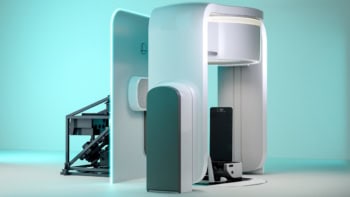
A new type of fibre laser that operates in the mid-infrared range has been designed by researchers in Australia. The device uses a dual-wavelength pumping approach that makes it 25 times more powerful than existing fibre lasers operating at mid-infrared wavelengths. The new design also makes the laser cheaper to produce than others and the device could have a variety of applications – from atmospheric analysis to non-invasive medical diagnosis.
Many common hydrocarbon molecules absorb light in the mid-infrared range, and therefore a cheap and convenient source of laser light in this part of the spectrum could have a variety of practical applications. The greenhouse gases methane and ethane, for example, could be remotely detected with mid-infrared laser radar systems. Such lasers could also be used in medical diagnoses to detect trace gas concentrations in exhaled breath that are symptomatic of some diseases and metabolic processes. The presence of acetone on the breath, for example, is associated with diabetes. Similarly, formaldehyde can be indicative of breast cancer and varied concentrations of carbonyl sulfide can offer clues to the health of the liver.
Also in a medical vein, it is believed that mid-infrared wavelengths could be beneficial to laser surgery, because they might be less destructive, resulting in less scarring. Furthermore, such lasers could also have a variety of defensive military applications – from active illumination for thermal cameras to jamming the detectors on board heat-seeking missiles, which operate in the 3–5 μm atmospheric window.
Bulky and expensive
The problem, however, is that practical lasers operating at these wavelengths have been very difficult to produce. Crystal lasers tend to be expensive and bulky. On the other hand, fibre lasers have their own problems. Traditionally, fibres are based on silica, which is opaque in the mid-infrared, necessitating the use of more exotic glass fibre. ZBLAN, a type of heavy metal glass based on zirconium fluoride, is commonly used for this purpose.
To make matters worse, mid-infrared transitions in rare-earth ions (such as erbium, used in this study) are located high above the ground state – resulting in a low overall efficiency, thanks to the difference in wavelengths between the emitted laser photon and the input pump photon. The relaxing ions also tend to get stuck in relatively long-lived excited states on their way back down to the ground state – with this forming a “bottleneck” that can lower efficiency at best, or prevent further lasing at worst.
Dual-pumping approach
To overcome these problems, the University of Adelaide researchers actually took advantage of the bottlenecking phenomenon. They used a dual-pumping approach that uses a relatively weak pump source to excite the ions to the low, long-lived excited state. Then a second pump raises them further to the most excited level.
When the ions subsequently relax to the long-lived state – emitting a photon as they do so – they can then be pumped up again, without delay. “This method allowed an order of magnitude improvement in efficiency compared to other fibre lasers operating on this transition,” says lead author Ori Henderson-Sapir, a researcher at the University of Adelaide. The team’s laser produces more than 0.25 W at wavelengths around 3.5 μm, with a significant peak in emissions at 3.6 μm. “To the best of our knowledge, [this is] the highest power, highest efficiency and the longest wavelength of a room-temperature fibre laser without using nonlinear effects,” he explains.
“This work represents a step forward for the creation of long-wavelength fibre lasers,” says Darren Hudson, a physicist at the University of Sydney, who was not involved in this research. “By optimizing the laser cavity, the authors were able to increase the slope efficiency of this laser to 18%, which represents a great improvement over the previous result of 3%, which was achieved using a single 655 nm pump laser.”
High-powered future
Hudson notes that another significant advantage of the two-pump process comes in its reduced cost – with the two smaller pump lasers costing less than one larger pump. He cautions, however, that current power output of the laser would be too low for laser surgery or many defence applications, but that the inherent scalability of fibre systems should allow greater powers to be developed in the future.
Having demonstrated the basic principle of their dual-pumped design, the researchers are now working on developing the capacity to tune their laser’s output wavelength. Their current aim is to create a system that is tunable between 3.3–3.8 μm. This would make it sufficient to enable the simple detection of various hydrocarbons for environmental and medical applications.
The research is published in Optics Letters.



